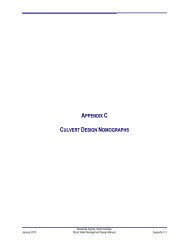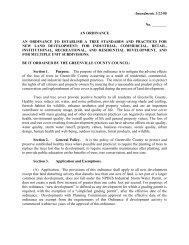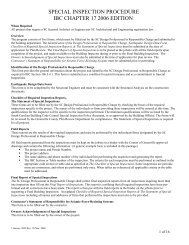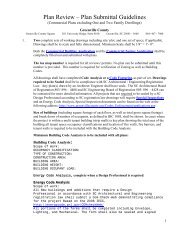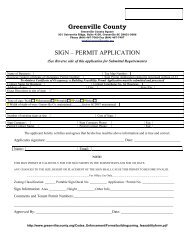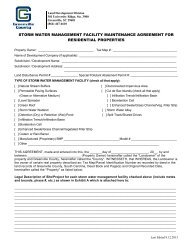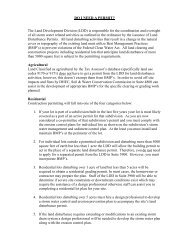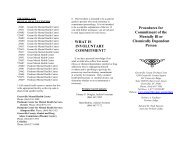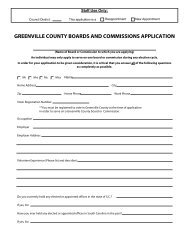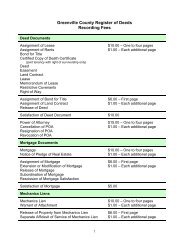Entire Design Manual - Greenville County
Entire Design Manual - Greenville County
Entire Design Manual - Greenville County
Create successful ePaper yourself
Turn your PDF publications into a flip-book with our unique Google optimized e-Paper software.
Development shall be fitted to the topography and soils so as to create the least erosion potential;<br />
Natural vegetation shall be retained and protected wherever possible;<br />
Natural vegetation and non-structural methods shall be employed to the extent possible, for<br />
streambank stabilization and erosion control in place of structural methods wherever possible;<br />
Only the smallest practical area shall be exposed and then only for the shortest practical period of<br />
time;<br />
Erosion control practices such as interceptor ditches, berms, terraces, contour ripping, soil erosion<br />
checks, and sediment basins shall be installed to minimize soil and water losses;<br />
Temporary vegetation or mulching shall be used to protect areas exposed during the time of<br />
development;<br />
During and after development, storm water management practices shall be utilized to effectively<br />
accommodate increased runoff caused by changes in soil and surface conditions, and to avoid<br />
siltation of receiving streams;<br />
Permanent vegetation and structures shall be installed in the development as soon as the weather<br />
permits;<br />
The design of outlet channels for the discharge of storm runoff shall be based on the runoff from<br />
predicted storm frequency and shall include the vegetative or structural measures required to protect<br />
the channel from scour and erosion;<br />
Waterway stabilization structures such as drop structures, grade stabilization structures, and channel<br />
liners shall be utilized to dissipate the energy of flowing water by holding the waterway slopes and<br />
velocities within non-erosive limits;<br />
Sediment basins and traps:<br />
1) Sediment shall be removed mechanically when the sediment basin behind the temporary barrier<br />
or the dam becomes filled, to an elevation shown on the plan or when the design capacity has<br />
been reduced by 50%. The structure may be removed once stability is reached in the<br />
development area;<br />
2) A sediment basin or sediment trap may be required to be enclosed, in the discretion of the<br />
Director, when necessary to ensure public safety;<br />
Cut and fill slopes and other exposed areas shall be planted or otherwise protected from erosion<br />
before the release of the permit obligations. The responsibility shall remain with the permittee or<br />
owner until the planting is well established;<br />
Fill may not be deposited beyond the mean high-water line unless the fill is used for marsh creation<br />
or shore restoration and does not extend beyond the mean low-water line or the fill is placed behind<br />
a structural shoreline erosion control device;<br />
Calculations for design of all BMPs for sediment control must be included as part of the permit<br />
application. Locations and timing of installation of sediment control BMPs must be shown on the<br />
Sediment and Erosion Control Plan and included as part of the SWPPP;<br />
Description of measures to prevent the discharge of solid materials, including building materials, to<br />
waters of the State and the United States, except as authorized by a permit issued under section 404<br />
<strong>Greenville</strong> <strong>County</strong>, South Carolina<br />
January 2013 Storm Water Management <strong>Design</strong> <strong>Manual</strong> 3-14



